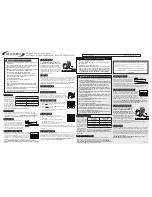
9
4. Connect the conductors of the loads to the +AUX-, +AUX1-, +AUX2-, +AUX3- terminals of the terminal box on
the power-supply unit.
5. If necessary, connect the conductors from the equipment to the technical outputs:
- BS AC status indication (alarm panel, controller, signalling unit, LED diode, etc.)
- AW technical output of failure
- TAMPER signalization of power-supply unit opening or separating from foundation.
6. Using the jumper
‘J1’
,
‘J2’
determine maximal battery charging current, take into consideration battery
parameters (refer to tab.1 page 4).
7. Using the jumper
‘J’
determine whether the function of disconnecting the discharged battery U<10V (+/-5%) is
to be on or off.
The battery protection is on
if the jumper ‘J’ is removed.
8. Activate the 230V AC supply (the AC diode should be permanently illuminated, and AUX O1, O2, O3 diode
should be permanently illuminated).
9. Check the output voltage (the power-supply unit voltage without load should be anywhere between
13.6V÷13.9V, and during battery charging 11V÷13.8V). If the value of the voltage requires adjustment, the
setting should be made by means of the potentiometer P1, monitoring the voltage at the AUX output of the
PSU.
10. Connect the battery in accordance with the indications: +BAT red to ‘plus’ , -BAT black to ‘minus’, (the LB red
diode should go on and the lighting intensity should reduce with the charging time elapsed increasing).
11. Once the tests and control operation have been completed, lock the enclosure, cabinet, etc.
3. The power supply operation indication.
3.1. Optical indication.
The PSU is equipped with two diodes on the front panel:
RED DIODE:
•
lights – the power-supply unit supplied with 230VAC
•
does not light – no 230VAC supply
GREEN DIODE
•
lights – DC voltage at the AUX output of the power-supply unit
•
does not light – no DC voltage at the AUX output of the power-
supply unit
Moreover, the PSU is equipped with three diodes indicating operation status: AC, LB, AUX, O1, O2, O3,
and UVP, placed on the PCB (fig.2) of the power-supply unit module:
•
AC - red diode
: under normal status (AC supply) the diode is permanently illuminated. The absence of AC
supply is indicated by the AC diode going off.
•
LB - red diode
: indicates the battery charging process; the intensity of illumination is dependent on the
charging current.
•
AUX
-
green diode
: indicates the DC supply status at the output of the PSU. Under normal status, the
diode is permanently illuminated and in the case of short-circuits or overload, the diode goes off.
•
O1, O2, O3
-
green diodes:
indicate the status of DC power supply at AUX1, AUX2, AUX3 outputs, which
are independently protected with 2.5A polymer safety equipment. In normal state, the diode emits
continuous light – in the case of short-circuit or overload, the diode goes off.
•
UVP – red diode: signals the activation of the UVP overvoltage protection.
In normal state, the diode
is off – in the case of short-circuit or overload, the diode emits continuous light.
3.2. Technical outputs.
The PSU is equipped with indication outputs:
•
BS - absence of AC supply output
: - OC output type indicates the loss of AC supply in a normal status,
with the supply equal to 230V, the output is deactivated and in case of power supply loss the PSU
activates the output after 30s.
•
AW - technical output of failure
: OC output type indicates failure the occurrence of at least one of the
following failures: SCP, OLP, UVP, voltage converter failure. In normal state (correct operation), the output
has the L status "ground" (0V) – in the case of failure, the output is open (hi-Z high impedance).





























